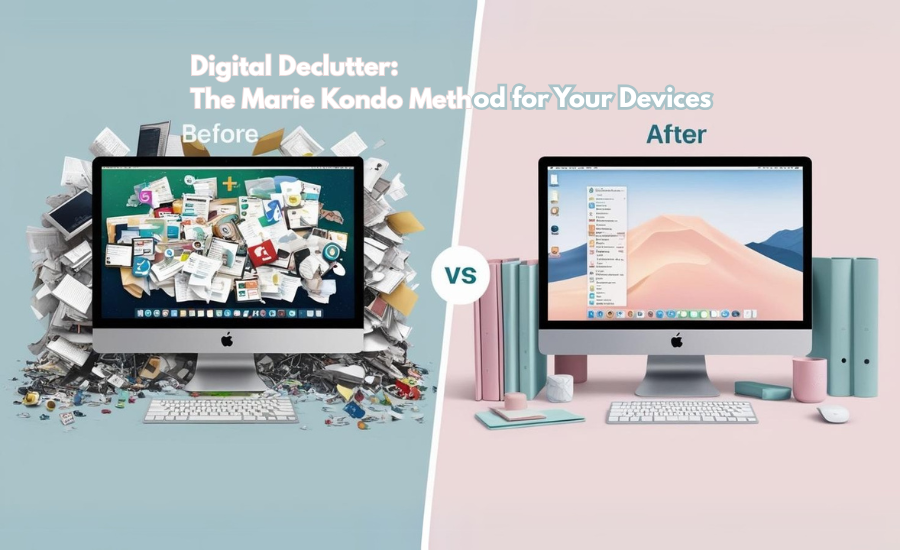
Just like our homes, our digital lives can become cluttered and overwhelming. We accumulate countless files, apps, emails, and social media connections that no longer serve us, weighing us down and draining our energy.
But what if you could apply the magic of Marie Kondo’s KonMari Method – famous for transforming cluttered homes – to your digital world? This blog post will guide you through a digital declutter using the KonMari principles, helping you create a more organized, efficient, and joyful virtual life. Are you ready to spark joy in your digital spaces?

Understanding the KonMari Method (for the Digital World)
The KonMari Method, developed by Marie Kondo, is a philosophy of decluttering that focuses on keeping only items that “spark joy.” While originally designed for physical possessions, its core principles can be effectively applied to the digital realm.
Key KonMari Principles
- Commit Yourself to Tidying Up: Approach your digital declutter with intention and a commitment to seeing it through.
- Imagine Your Ideal Lifestyle: Visualize how you want your digital life to look and feel. What activities do you want to prioritize? What kind of information do you want to consume?
- Finish Discarding First: Before organizing, you must first discard everything that doesn’t spark joy or serve a necessary purpose.
- Tidy by Category, Not Location: Instead of decluttering one device at a time, tackle specific categories (e.g., photos, files, apps) across all your devices.
- Follow the Right Order: The KonMari Method has a specific order for tidying physical items (clothes, books, papers, komono (miscellaneous items), sentimental items). We’ll adapt this order for the digital world.
- Ask Yourself: “Does This Spark Joy?” This is the central question of the KonMari Method. For digital items, this translates to: “Is this useful, necessary, or does it bring me positive feelings?”
Adapting KonMari for Digital Decluttering
Here’s how we’ll adapt the KonMari categories for the digital world:
- Digital “Clothing”: Apps
- Digital “Books”: Files (documents, downloads, ebooks)
- Digital “Papers”: Emails and digital notes
- Digital “Komono”: Everything else (browser bookmarks, saved passwords, streaming service subscriptions, etc.)
- Digital “Sentimental Items”: Photos and videos
Step 1: Decluttering Your Apps (Digital “Clothing”)
Start with your apps, as they’re often the most visible and frequently used part of our digital lives.
Gather All Your Apps
Make a list of all the apps on your phone, tablet, and computer. You might be surprised by how many you’ve accumulated!
Hold Each App (in Your Mind) and Ask: “Does This Spark Joy?”
Consider each app individually. Does it:
- Serve a Practical Purpose? (e.g., banking, navigation, productivity)
- Bring You Joy? (e.g., games you genuinely enjoy, creative apps)
- Enhance Your Life? (e.g., fitness trackers, meditation apps)
If the answer is “no” to all of these, delete it. Be ruthless!
Organize Your Remaining Apps
Group your apps into logical categories (e.g., Productivity, Social, Entertainment, Utilities). Use folders or labels to keep your home screen organized.
Turn Off Unnecessary Notifications
For the apps that do make the cut, be intentional about notifications.
Step 2: Decluttering Your Files (Digital “Books”)
Next, tackle your files – documents, downloads, ebooks, and anything else cluttering your computer’s storage.
Create a Temporary “Inbox” Folder
Create a temporary folder on your desktop called “Inbox” (or something similar). Move all your files (from your desktop, Downloads folder, Documents folder, etc.) into this inbox.
Process Each File One by One
Go through each file in the inbox and ask yourself:
- Is This Necessary? Do you need this file for work, legal, or financial reasons?
- Is It Useful? Will you refer to this file again in the future?
- Does It Spark Joy? (This might apply to creative projects, ebooks you love, etc.)
If the answer is “no,” delete it. If the answer is “yes,” move it to a clearly labeled folder within a well-organized file structure.
Create a Logical File Structure
Develop a clear and consistent file structure that makes it easy to find what you need. Use descriptive folder names and subfolders. (e.g., Work > Clients > Client Name > Project Name).
Embrace Cloud Storage
Consider using cloud storage services (like Google Drive, Dropbox, or iCloud) to store important files. This frees up space on your devices and provides a backup in case of hardware failure.
Step 3: Decluttering Your Emails and Digital Notes (Digital “Papers”)
Time to tackle your inbox and any digital note-taking apps you use.
Aim for Inbox Zero (or Close to It)
Process your emails regularly, aiming to keep your inbox as empty as possible. Use the following actions:
- Delete: Get rid of anything you don’t need.
- Archive: Archive emails that you might need to refer to later but don’t require immediate action.
- Respond: Reply to emails that require a response.
- Delegate: Forward emails to others if they can handle them better.
- Do: If an email requires a quick action (less than 2 minutes), do it immediately.
Unsubscribe from Unnecessary Newsletters
Unsubscribe from any email newsletters or mailing lists that you no longer read or find valuable.
Organize Your Digital Notes
Apply the same KonMari principles to your digital notes. Delete notes you no longer need, organize the remaining notes into logical categories, and use tags or keywords for easy searching.
Step 4: Decluttering Digital “Komono” (Everything Else)
This category includes a variety of miscellaneous digital items.
Browser Bookmarks
Review your browser bookmarks and delete any that are outdated, irrelevant, or no longer of interest. Organize your remaining bookmarks into folders.
Saved Passwords
Use a password manager to securely store your passwords. Delete any saved passwords that you no longer use.
Streaming Service Subscriptions
Review your streaming service subscriptions (Netflix, Spotify, etc.) and cancel any that you’re not using regularly.
Social Media
- Unfollow/Unfriend: Unfollow or unfriend accounts that don’t bring you joy, inspire you, or provide valuable information.
- Limit Notifications: Turn off unnecessary social media notifications.
- Take Breaks: Consider taking regular breaks from social media to reduce overwhelm and improve your well-being.
Step 5: Decluttering Digital “Sentimental Items” (Photos and Videos)
This is often the most challenging category, but also the most rewarding.
Gather All Your Photos and Videos
Gather all your photos and videos from all your devices and cloud storage accounts into one central location (e.g., an external hard drive or a dedicated cloud storage service).
Delete Duplicates and Blurry/Poor Quality Photos
Start by deleting any duplicate photos, blurry photos, or photos that are of poor quality.
Choose Only the Photos That Spark Joy
Go through the remaining photos and videos and ask yourself, “Does this spark joy?” Keep only the photos and videos that evoke positive memories or have significant sentimental value.
Organize Your Photos and Videos
Organize your photos and videos into folders by date, event, or person. Use keywords or tags to make them easy to search.
Consider Creating Physical Albums or Photo Books
Consider creating physical albums of photos.
Conclusion: Enjoy Your Tidy Digital Life
Digital decluttering, like physical decluttering, is an ongoing process. By applying the KonMari Method to your devices, you can create a more organized, efficient, and joyful digital life. You’ll free up space, reduce distractions, and gain a greater sense of control over your virtual world. Embrace the digital tidy-up and experience the transformative power of a decluttered digital life!
Frequently Asked Questions (FAQs)
Q1: This seems overwhelming! Where do I start?
A1: Start with the easiest category for you – perhaps apps or browser bookmarks. Once you’ve made progress in one area, you’ll feel more motivated to tackle the others.
Q2: What if I’m afraid of deleting something I might need later?
A2: Create a “Maybe” folder for items you’re unsure about. Revisit this folder in a few months and see if you still need those items.
Q3: How often should I do a digital declutter?
A3: Aim for a major digital declutter at least once a year, and do smaller maintenance declutters (e.g., processing your email inbox) regularly.
Q4: How can I maintain my digital organization after decluttering?
A4: Schedule regular time for the task.
Q5: Is there a specific order to follow?
A5: Yes, the order is listed above.
Also Read..Digital Detox and Career Growth






